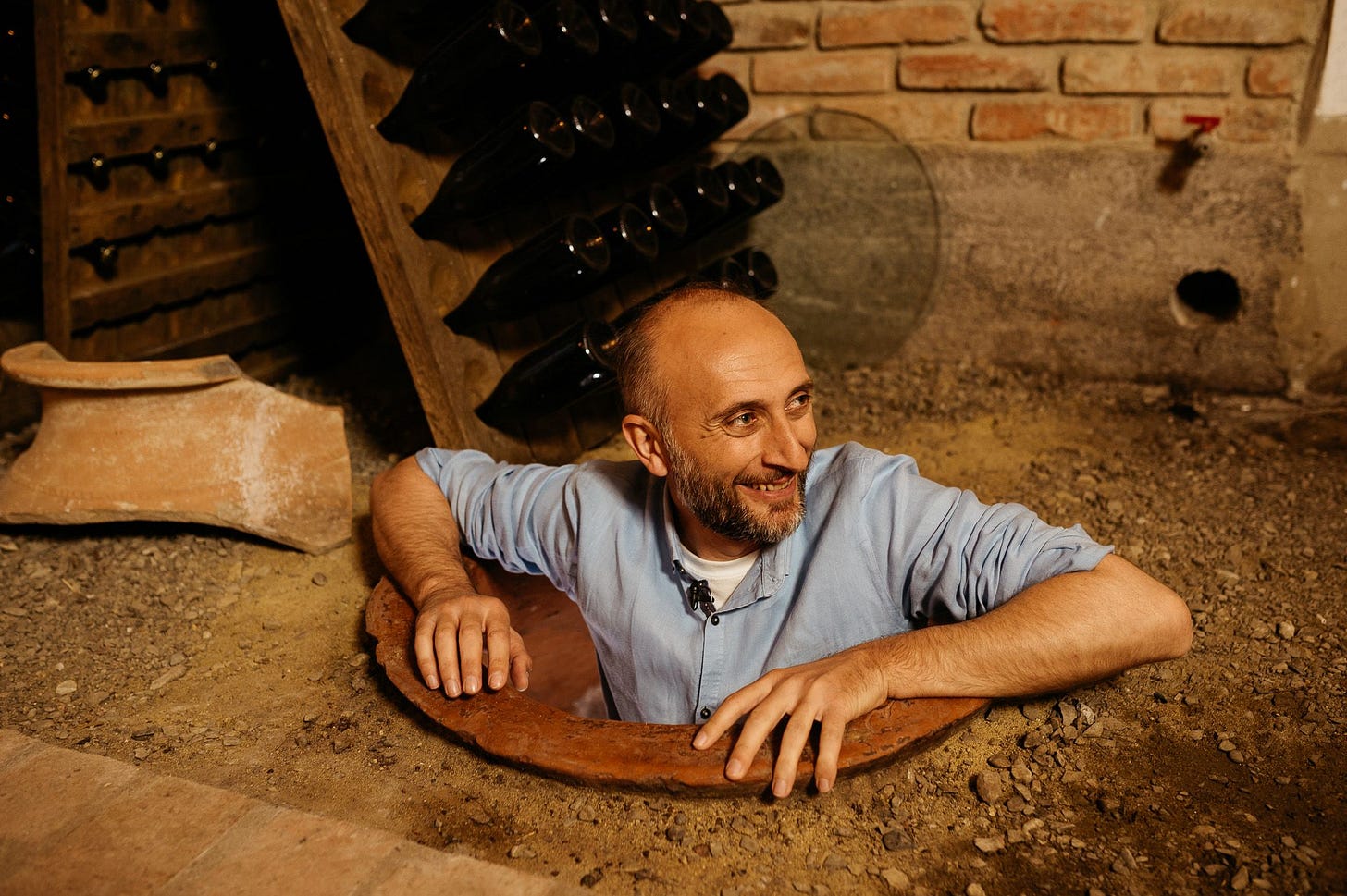Georgia's new age of amber
Simon takes a look at the extraordinary expansion in traditional qvevri winemaking in Georgia. What does it mean for quality, and how do you know what's really in the bottle?
When Iago Bitarishvili organised a pioneering tasting of traditional Georgian qvevri wines in 2009, he went looking for fellow winemakers who were producing the style on a commercial basis. He found just five across the whole country.
"Georgian technology" as it's affectionately known had been albeit abandoned by the beginning of the 21st century.
Those five wineries were Pheasant's Tears, Ramaz Nikoladze, Our Wine (Soliko Tsaishvili RIP), Vinoterra (now Schuchmann wines) and Alaverdi Monastery.
If Iago organised the same tasting in 2020, he'd be able to choose from well over 150 wineries. Yes, it's a vague estimate. Figuring out how many wineries in Georgia produce the traditional qvevri style is close to impossible. Even Georgia's National Wine Agency doesn't record this information. However, help might be at hand from the OIV, who are about to ratify a new "white wine with maceration" category. Irakli Cholobargia (a senior advisor at the NWA) suggests that from 2021 Georgia's amber wines (which represent the apothesis of the qvevri tradition) may finally be categorised as such - rather than simply being bundled invisibly into the white wine category.
An official amber wine category?
Some more detail about that OIV addition: It's been reported in the Georgian press as an "amber wine" category, specific to Georgia. National pride may have slightly distorted the facts. As confirmed to The Morning Claret by the OIV's head of economy and law Tatiana Svinartchuk, the OIV's committee rejected both the names "amber wine" and "orange wine" as confusing - hence the neutral (and in my opinion equally confusing) phrase "white wine with maceration".
The new OIV category is the eighth to be included in a list of "special wines" alongside styles such as sparkling, liqueur or flor-affected wines). Georgia was instrumental in petitioning the OIV for the creation of this category, mainly so that amber/orange wines can be properly signposted at wine competitions, and not risk being marked down as faulty white wines. The OIV recognises Georgia and specifically "the ancient Georgian method of winemaking in traditional Qvevris, inscribed on the UNESCO Representative List of the Intangible Cultural Heritage of Humanity in 2013", however the category allows wines from any country, provided they meet the following specification:
The OIV defines "prolonged contact" as a minimum of one month's "maceration", and specifies that the wine "can be characterised by an orange-amber colour and a tannic taste." Presumably Elisabetta Foradori's Nosiola Fontanasanta (nine months on skins, but light in colour and delicate in texture) need not apply - neither should Dario Prinčič's Pinot Grigio (dark and tannic, but only a week of skin contact) nor Mlečnik's Cuvée Ana (a giant among orange wines, but with only three or four days of skin contact).
I digress.
Explosive expansion
In 2009, qvevri wines were only just starting to become available outside Georgia - and they variously captivated and shocked wine drinkers who had never seen or tasted anything like them before. I remember my own flabbergastment when I first tasted some amber wines at the Real Wine Fair in 2012. Now, according to Georgia's National Wine Agency there are 350 wine producing/processing companies with export licenses - plus a further 1,165 who do not (yet) export.
The NWA estimates that somewhere between 150 - 250 of these produce the traditional qvevri style. Their figure is calculated by taking the membership of Georgia's Natural Wine Association (150), adding the members of the Bolnisi Wine Association (a further 35 maranis all making qvevri wines) and then estimating that there are at least a further 50 wineries not in either of these organisations.
It's a far cry from the early days of Georgia's independence, when its wine industry consisted only of commercial "wine factories" that had been taken over from the soviet days and repurposed into private JSCs (Joint Stock Companies). Back in the 1990s, the only game in town was bulk production of semi-sweet plonk destined for the Russian market. Now, Georgia exports just shy of 100 million bottles a year (admittedly 60% of which still ends up in Russia), and of this, perhaps 5% (or 5 million bottles) is qvevri wine.
A flood of new wineries contributes to this significant niche production, all claiming to be the real deal. "Traditional Georgian method", "natural wine" and other non-legally binding phrases abound on the labels, which often look like design throwbacks to the 19th century.
Boom or bust?
Some of these wines and winemakers deliver the goods, but inevitably some are bandwagon-jumpers and some showcase decidedly amateur winemaking. Far too few of these wineries grow 100% of their own fruit, often sourcing either via old-timers with fragmented plots or other less than transparent routes. With Georgia's existing vineyards in terrible condition by the time the country became independent in 1991, top quality fruit - especially from organic viticulture - is in very short supply.
Then there are the subtle differences which remain opaque on wine labels. Not all "qvevri wines" are the small production, artisanal product that you might expect. An increasing number of the major wineries have introduced boutique qvevri lines - the frontrunners here are Tbilvino ("Qvevris"), Telavi Wine Cellar (Satrapezo) and Schuchmann (Vinotera). Whilst these are often good, they can sometimes lack authenticity (Satrapezo's Mtsvane is aged in barriques) and the viticulture will be at best conventional.
Then there are legion producers who make qvevri wines but who would not necessarily qualify as "natural". There is nothing to stop a winemaker adding selected yeasts to the qvevri (although this is rare), and filtration, cold-stabilisation, fining and sulphuring are often practised to make wines more stable and "export friendly".
Finally there's the real McCoy - those growers who adhere faithfully to the time-honoured Georgian tradition - no additives, no filtering or other processing, no oak ageing - just "Georgian technology". The best of these growers also practice organic or biodynamic viticulture - although a minuscule number have achieved certification. The more reliable guarantee of these principles is to look for members of the Natural Wine Association. At the time of writing, the list of members on their website is frustratingly non-operational.
And don't be fooled - just because a picture of a qvevri appears on the label, it doesn't follow that the liquid inside the bottle ever came into contact with clay. There are plenty of shameless marketeers in Georgia. That said, a small number of growers have shown that authentic "Georgian style" wines can be made even in steel tanks. My recommendations include Nine Oaks, Dano and Georgian Sun.
The amber nectar
Here's the rub - we're all in love with the simplicity, timelessness and rusticity of Georgia's qvevri style, but nailing it needs a skilled and experienced hand. The difference between a perfectly made qvevri wine vinified from top quality fruit, and a clumsy example from a cellar with poor hygiene or a vineyard with scant quality control is vast. Foul, fault-ridden wines still dog the industry, even if they are receding in number compared to a decade ago.
Nonetheless, lovers of the traditional Georgian qvevri style have never had it so good. I reviewed 73 Georgian wines over the last few months, many from producers previously unknown to me. Here are some favourite amber discoveries:
[rcno-reviews id=9232 ]
[rcno-reviews id=10707 ]
[rcno-reviews id=10832 ]
[rcno-reviews id=10841 ]
[rcno-reviews id=10844 ]
Here are three qvevri-fermented reds that were all quite sensational in their own ways:
[rcno-reviews id=10869 ]
[rcno-reviews id=10870 ]
[rcno-reviews id=10714 ]
For more, view all my reviews of Georgian wines here.
If you enjoyed this article, please consider supporting the site by taking a glance at the shiny things in our online shop






